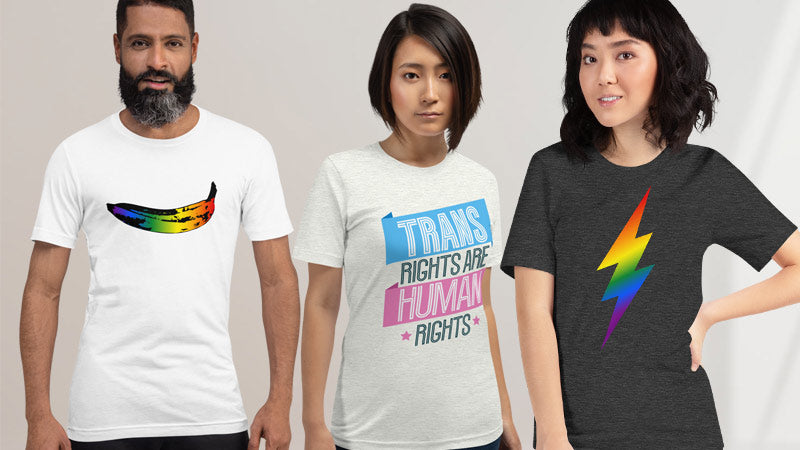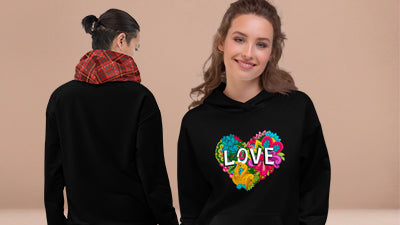What Is Gender: A Guide to Gender Identities

There has never been a more important time to write, talk and think about how gender manifests itself for different people. Over the last 10 years gender has become one of the hottest topics around the world. While conservative rhetoric aims to force everyone into birth-assigned binary boxes of male and female, non-conforming people are living proof that gender is far more complex and expansive than the accepted wisdom previously allowed.
But what is gender, and how do different people understand it? Those who seek to delegitimise gender non-conforming people often talk of the 97 genders (or whatever number they pluck out of the air) as a way to ridicule. But what they’re actually saying is that they’re scared. Scared of change, scared of a greater understanding of the human condition. And unable to accept that a world view they had become comfortable with is no longer valid.
This article is a snapshot guide to the many ways in which people experience their gender now. Many of these identities may well be new to you, but it’s important to understand that this isn’t a new phenomenon. Gender non-conforming people have always existed, it’s just that up to now there wasn’t the varied language to describe the different ways gender exists.
What Is Gender?
Gender is understood to be different to biological sex. Sex is a classification defined by chromosomes (usually XX for male and XY for female, although Intersex people may have other combinations), and also reflects the hormones produced by the body and the reproductive organs.
Gender on the other hand is a social construct based on how you feel, how you present yourself, how you express yourself. Many gender non-conforming people feel dysphoria (which is a profound sense of unhappiness or distress) at the disconnect between the biological sex they were assigned at birth and their physical body or their gender identity. That’s why it’s always important to be sympathetic and not define others by the sex you perceive them to have, but to respect the gender they identify as.
Tumblr user Oltiel, who coined one of the below terms, described gender as usually defined in terms of four elements: masculine, feminine, androgynous or neutral. And below these you may add fluidity, fluctuation, combination and intensity to create more highly defined subgenders. However, others feel that gender is expressed better in terms of transgender, cisgender, neutral and agender.
All of the above can be readily understood by people. However, there are also other, new ways to understand gender and these are the range of Xenogenders.
What Is Gender Identity?
A common interpretation of gender is that it’s a spectrum, with male/masculine on one end, female/feminine on the other, and androgynous or non-binary in the middle. Alternatively you may conceptualise gender as a universe, with every planet, star, or asteroid representing a different manifestation of gender. You can exist in the same solar system as someone else, but ultimately we are all unique and experience gender in subtly different ways.
Gender identity is how you feel, how you choose to identify. For example, my gender identity is non-binary. This is what I would write in a form (if there’s an option other than male or female) or tell to people who ask me. Gender identity includes the pronouns you prefer people to use, and the words you’d like people to refer to you as. It can also include your name, which many people change to reflect their preferred gender.
Gender presentation is how you appear to others. It doesn’t always correlate with sex and gender, for example your identity could be male but you might enjoy wearing dresses, which are traditionally associated with feminine presentation. It’s important to remember that trans men don’t owe anyone masculinity, trans women don’t owe anyone femininity, and non-binary people don’t owe anyone androgyny.
Gender expression incorporates presentation but also behaviour, body language, voice, and everything else that shows our personality to others. Think about all the ways you can express yourself – through make up and the way you walk, to more abstract ideas such as your energy or your aura.
How Many Genders Are There?
It’s impossible for everyone to agree on a set number of genders, partly because gender is an evolving thing, and new identities and more tightly defined sub-identities are being created all the time, but we know that there are many! I once read a quote that said, ‘there are as many genders as there are people in the world.’ Whether you believe this or not, there’s certainly more than the traditional idea of two.
There are dozens of nuanced identities, existing within umbrellas such as cis, trans or non-binary. For this article, we have settled on 22 binary related gender identities and nine that fall outside of the binary. Although we realise that there are hundreds of sub, micro and neo gender identities.
We have focussed on the most common and distinct and, for brevity, left out the more niche ones, or where there is a large overlap or where an umbrella term has multiple subgenders we haven’t included all of those those.
Please note that Sexual Orientation, Asexual identities and Aromantic spectrum identities are separated into their own articles. Also that Intersex is not a gender identity, it is a separate identity on its own.
Gender Identities and Definitions
Transgender
Or trans for short, (or even trans+) has become an umbrella term. ‘Trans’ is a Latin prefix meaning across, beyond, or on the other side of. So transgender meant identifying as the gender on the other side of the one assigned at birth.
That used to mean binary trans women or binary trans men. But the meaning has evolved to simply mean different from the gender assigned at birth. The evolution of the label means it might mean something slightly different for each trans person.
And it is very much defined as how people identify, and anyone should be free to identify as trans, so medically transitioning is not a requirement. Trans+ is a newer label that seeks underline inclusivity of other groups, as many Non-binary, Agender, Gender fluid or Genderqueer people also identify as trans, regardless of whether they have chosen to medically transition.
Two-Spirit
A term used by some Indigenous people who identify as having both a masculine and a feminine spirit. Often shortened to 2S, the term was coined in 1990 at a Native American LGBTQ+ conference, and was not intended to replace traditional terms already used by queer Indigenous cultures, but to highlight the historical significance of Native gender identities beyond the Western binary of male and female.
This is for Native/Indigenous/First Nation North Americans only, and should not be appropriated by those who do not have that heritage. Even within tribes, the term has not been widely accepted or used.
Gender fluid
This term is perfect for those who feel like their gender frequently moves between expressions such as masculine, feminine, Non-binary or Androgynous. Their identity may change hourly, daily, weekly, or at random. It is not a fixed identity, and therefore Gender fluid people may have different names or pronouns at different times to reflect their current state.
Genderqueer
This is an umbrella term, often used by people who prefer not to use a specific label, or for the community at large. It refers to people who don’t entirely identify as either binary male or female. Coined in the 1990s, this term often has a political or radical vibe to it.
Genderflux
This term refers to the level of intensity someone feels towards their gender. For example, someone who is Genderflux may fluctuate between intense feelings of femininity to partial femininity to genderless. You can be Genderflux on any part of the gender spectrum.
Transexual
This is an identity that has largely been superseded by Transgender, but there is a critical difference. Although few identify as Transexual now, it refers to those people who not only experience a dysphoria in their body and gender identity, but who undergo medical treatment in the form of hormone therapy or surgery to match their physical body with their gender.
It’s a medicalised term, and has largely been rejected due to its inclusion of the word sex, as a way to separate gender identity from sexual orientation and to distance trans people from sex work.
Transmasc
This umbrella term can be used for transgender men or Non-binary people who also identify with masculine gender expressions. Effectively anyone who was assigned female at birth (AFAB) but identifies partly or wholly masculine. It can include those who present masculine or who have undergone medical transition. Transmasc people can also identify as other genders.
Transfemme
An umbrella term can be used for trans women or Non-binary people who also identify with feminine gender expressions. Effectively anyone who was assigned male at birth (AMAB) but identifies partly or wholly feminine. It can include those who present feminine or who have undergone medical transition. Transfemme people can also identify as other genders.
Genderfae
When your gender is fluid between multiple feminine, neutral or unaligned genders, such as female and non-binary, but never any masculine or male aligned genders. Also known as Genderdoe or Genderthil.
Genderfaun
When your gender is fluid between multiple masculine, neutral or unaligned genders such as male and non-binary, but never feminine aligned or female genders. Also known as Genderfawn.
Cisgender
Cisgender people are those whose gender identity is the same as the sex they were assigned at birth. ‘Cis’ being the latin prefix for same. It’s worth remembering that cis people can still be any degree of same sex attracted, Asexual or on the Aromantic spectrum.
Multigender
An umbrella term for people who experience many genders and these identities can be experienced simultaneously, fixed or fluidly. Bigender and Trigender, are sub-categories of this term.
Bigender
A multigender identity where a person identifies as two distinct genders. Someone who identifies as bigender could identify as any combination of binary or Non-binary genders and can be fixed or fluid. They could identify as both at the same time and do not have to identity as both in equal measure.
Ambigender
A multigender identity subgender of bigender, where a person identifies as two distinct genders but with no fluidity of fluctuation. Someone who identifies as bigender could identify as any combination of binary or Non-binary genders.
Trigender
A form of multivendor where a person identifies as exactly three distinct genders. These could be any combination of binary or Non-binary genders and their identification can be fixed or fluid.
Pangender
Pan is a prefix from Greek meaning all or every, so Pangender (also known as Omnigender) people identify with all the genders available to them. They cannot identify with genders outside of their cultural experience, for example Indigenous conceptions of gender or gender identities related to neurodivergent conditions. Pangender is a type of Polygender or Multigender identity that is defined by an identification with an unspecified number of genders.
Polyfluid
For people who are Polygender and also Gender fluid. So they tend to be fluid between combinations of genders rather than single ones. Polyfluid people can, for example, be Non-binary and Demiboy at one time and then become Demigirl and neutrois at another time.
Graygender
The gray prefix refers to the level of ambivalence people feel towards gender. They’re not entirely genderless, but their experience of gender is not intense and is hard to define.
Pomogender
People who do not feel that any gender labels fit them, or they aren’t interested in specifying their gender identity. It can also be for people who simply don’t want to have a gender label.
Outherine
This is an umbrella term for those who identify with genders outside of the accepted qualities of masculine, feminine, androgynous and neutral. The qualities associated with this gender are known at Outherinty, (to match masculinity etc). It can also be used to describe a gender that is different to any described gender using completely new qualities, or one created by the combination of existing qualities that someone sees as combined to make the sum different.
Atrinary
An umbrella term for genders that are completely unrelated to the trinary genders (male, female or Non-binary). It differs from Non-binary in that NB can include genders inbetween the binaries of male and female. Whereas Atrinary gendered people feel a very strong sense of gender, but do not sit between or have any relation to male and female.
Anthrogender
This is the opposite to Xenogender, and so it is the umbrella term of any gender that can be described in terms its relationship to the Trinary genders: masculinity, femininity or neutrality. That a can also include those who are described by how they have no relationship to this genders, these are called Atrinary genders.
Genderless and Neutral Gender Definitions
Non-Binary
An umbrella term for people who identify outside of the traditional binary of male and female. They can use any pronouns, but many prefer gender-neutral ones such as they/them. Non-binary people can feel genderless or a combination of recognisable gender expressions.
As an umbrella term, many identities below fall under it. Non-binary can be used for any gender identity that isn’t cis or binary trans (trans man or trans woman). Some Non-binary people also identify as trans, and others see it as a separate identity.
Agender
This identity exists outside of the spectrum of maleness, femaleness and neutrality. Agender individuals describe themselves as having no gender at all, or being genderless. They are unlikely to use traditional pronouns such as he or she. Some agender people believe it should not be identified as a gender identity at all.
Demigender
An identity for people who only feel a partial connection to a gender identity. It can be an umbrella term which includes identities such as demi-girl and demi-boy, or a term in its own right for people who only feel somewhat connected to having a gender at all.
Demigirl
Someone who, irrespective of how they were assigned at birth, identifies partially, but not entirely as a girl/woman. The individual may also identify as any other gender, or combination of genders, or as having no other gender.
Demiboy
A person who identifies partially, but not fully as boy or man. This person may have been assigned either male or female at birth. And they may identify as any other gender or combination of genders, or have no other gender identity.
Androgyne
This can be an umbrella term for identities that simultaneously blend male and female expressions and presentations. Someone who identifies this way will usually enjoy androgynous aesthetics, and may experience gender fluidly or an overlap of male and female simultaneously.
Neutrois
An umbrella term for people who feel their gender very strongly but that gender is neither male nor female, and not in-between the two. However, some Neutrois individuals define it as being similar to Agender. Generally the accepted difference is that agender is the feeling of having no gender at all, while Neutrois is having a strong feeling of gender, but it’s not not male or female.
Demiflux
A combination of two or more gender identities with different intensities. For example, a demiflux person could feel fully male but their identification with femininity could fluctuate from intense to not intense.
Xenogender
Currently a huge area of neogender exploration and expansion. This is an umbrella term for a range of non-binary identities that relate to things, beings or concepts that are outside of the existing understanding of human gender. In other words they cannot be described in relation to masculinity, femininity, androgyny, neutrality, or outhernity. Xenogenders fall into six categories:
- Noungenders - where people describe their gender in terms of it being like an thing, such as an animal, a statue or a piece of clothing.
- Neurogenders - These are genders that are tied inseparably to a neurodivergent persons neurotype.
- Aesthetigenders - This includes genders that are associated with sensory elements such as how something feels, sound, smell, or things like light and dark.
- Mutogenders - Is a gender fluid range of genders, in which a person’s gender alters depending on situations, such as their location, who they’re with, or even based on the time.
- Nominalgenders - People who’s gender is tied so closely to themselves that their gender has become unique.
- Alterhumangenders - when a part of someones gender is nonhuman and is an intrinsic part of how they identify.
The range of Xenodenders is, by definition, almost infinite.













